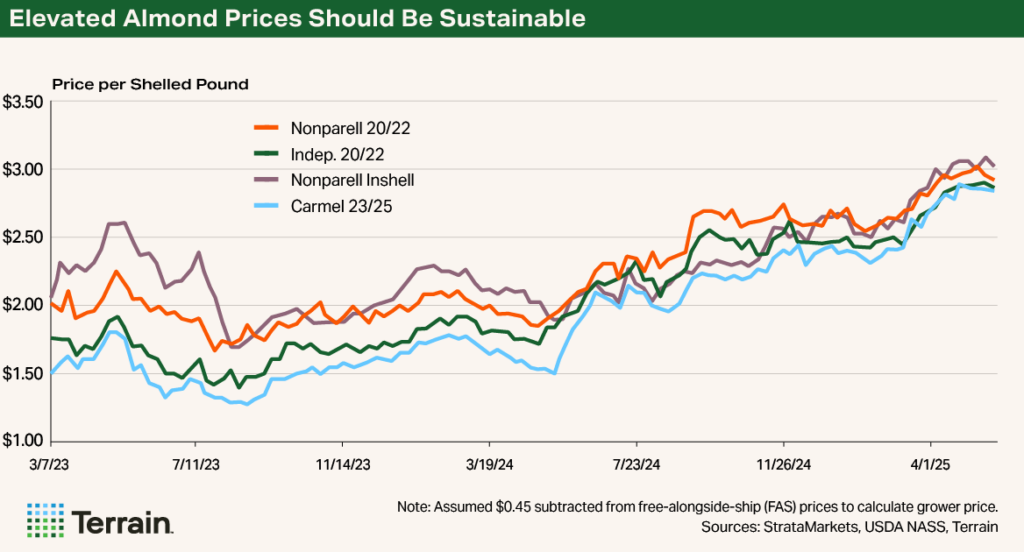Report Snapshot
Situation:
Almond prices have risen significantly in the last year as the industry’s supply-demand balance reached more sustainable levels.
Outlook:
The market is likely to remain balanced, which should keep prices elevated as we enter the new crop year.
Buying and Prices Could Remain Elevated
USDA's Subjective Estimate, on May 12, projected a crop of 2.8 billion pounds for 2025, up roughly 100 million pounds from the 2024 crop. The USDA Objective Estimate, the industry’s final estimate, is expected in July. With information being released about the 2025 crop, market activity has slowed and prices have dipped in recent weeks.
Whether the price dip reflects a new supply-demand balance or simply buyers’ waiting until more is known about the 2025 crop is the question of the moment. On the one hand, if buyers are taking a “wait and see” approach, the dip could be a temporary phenomenon that doesn’t reflect market fundamentals and should pass soon enough. On the other hand, the projected increase in supply may be large enough to make the downward pressure on prices more permanent for the 2025/26 crop year.
While the last few years have taught us that there are always curve balls in the almond market, the wait-and-see explanation is far more likely.
Market indicators point to a manageable supply heading into the 2025/26 crop and that, all else equal, prices should remain at elevated levels. A review of where we are in the current crop year helps paint this picture.
Supply and Demand Still in Balance
The 2024/25 crop year has been characterized by stable demand amidst slightly smaller supply. Year-to-date shipments in 2024/25 through May have been at 2.26 billion pounds, compared to 2.31 billion the year before and the five-year average of 2.23 billion.


Shipments by region provide greater insight into aggregate numbers.
- YTD exports to India are 3% lower than last year, with demand expected to strengthen in coming months as we approach Diwali, which occurs in late October this year.
- YTD shipments to China and Hong Kong have decreased by 51% as the region shifts toward Australia, which saw shipments increase 128% from the 2023/24 season to the 2024/25 season due, at least in part, to an existing free trade agreement.
- Europe remains stable compared to last year, with Germany's drop in demand balanced by increases from the Netherlands, Sweden and Italy.
Amid strong shipments and tighter supply, inventory is expected to remain tight. With 3.16 billion pounds in current supply and 2.26 billion pounds in YTD shipments, an average monthly shipment of 199 million pounds would result in a 500 million-pound carryover (equal to last year). Average shipments for June and July over the past five years suggest this is a very reasonable estimate and that it’s quite possible the carryout is even less than that.
Assuming a 2.8 billion-pound crop, and a 500 million-pound carry-in, supply in 2025/26 would be 3.3 billion pounds, only a 4% increase from the current supply on the higher end.
Though such an increase in supply could, in theory, put some moderate downward pressure on prices, tighter inventory globally and buyers’ needing to cover is likely to make up for that. Carryover in Australia coming out of its last season is extremely tight and inventories held among buyers likely are not sufficient given demand abroad.
A Strong Price Outlook
Overall, YTD shipments and current supply projections suggest that the industry will have a manageable supply going into the 2025/26 crop year. With global inventories tight and buyers in need of supply, we’re likely to see prices remain elevated as we head into the new crop year. I believe the market is pausing to absorb new information about the 2025 crop, but market fundamentals suggest a strong seller position.
Terrain content is an exclusive offering of AgCountry Farm Credit Services,
American AgCredit, Farm Credit Services of America and Frontier Farm Credit.